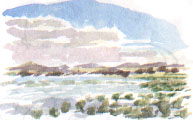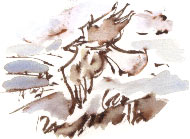Richard Bell's Wild West Yorkshire nature diary
Hicksons Lakes
‹previous
| this month | home
page | e-mail me | next›
Wednesday, 27th December, 2006
 WE'RE
EXPLORING a corner of the RSPB Fairburn Ings Reserve which
we haven't visited before. At the Castleford end of the reserve there are two
lagoons, Hicksons Lakes set amongst low rolling grassy hills
. You see to your right as you drive north out of Castleford across the River
Aire and along the line of the Roman Road.
WE'RE
EXPLORING a corner of the RSPB Fairburn Ings Reserve which
we haven't visited before. At the Castleford end of the reserve there are two
lagoons, Hicksons Lakes set amongst low rolling grassy hills
. You see to your right as you drive north out of Castleford across the River
Aire and along the line of the Roman Road.
 We
visited this corner about 20 years ago and I remember the whole landscape being
unrelentingly grey because at that time they were dumping and bulldozing huge
quantities of colliery waste (grey coal measures shale). The track that we walked
over at that time was an expanse of glutinous mud. No wonder it's taken us twenty
years to come back here. These two lakes themselves would be an attractive bird
reserve but their importance is the way they link with the existing Fairburn
Ings lagoon which has been a nature reserve since the 1960s and the RSPB reserve
at Swillington which is now taking shape a few miles away.
We
visited this corner about 20 years ago and I remember the whole landscape being
unrelentingly grey because at that time they were dumping and bulldozing huge
quantities of colliery waste (grey coal measures shale). The track that we walked
over at that time was an expanse of glutinous mud. No wonder it's taken us twenty
years to come back here. These two lakes themselves would be an attractive bird
reserve but their importance is the way they link with the existing Fairburn
Ings lagoon which has been a nature reserve since the 1960s and the RSPB reserve
at Swillington which is now taking shape a few miles away.

 Remembering
that muddy morass from the previous visit we're grateful for the newly surfaced
all-weather path that takes you to a new hide (locked when we visited it). We
can spend more time birdwatching and less picking our way through mud. There
are fieldfares and redwings (left) in
the old hedges and teal and heron on reedy
backwaters.
Remembering
that muddy morass from the previous visit we're grateful for the newly surfaced
all-weather path that takes you to a new hide (locked when we visited it). We
can spend more time birdwatching and less picking our way through mud. There
are fieldfares and redwings (left) in
the old hedges and teal and heron on reedy
backwaters.
 We
clock up a total of 49 species of birds as we walk around the entire reserve,
53 species if you include the black swan and other obvious escapes. None of
them were exceptionally rare but it's good to see such a variety of regulars;
greylag goose, lapwing, green woodpecker
and skylark, for example.
We
clock up a total of 49 species of birds as we walk around the entire reserve,
53 species if you include the black swan and other obvious escapes. None of
them were exceptionally rare but it's good to see such a variety of regulars;
greylag goose, lapwing, green woodpecker
and skylark, for example.
 I
also get the best view I've ever had of a kestrel hovering.
It's only 20 yards from us, hovering at telegraph pole height over roadside
plough-land. Through binoculars it fills the frame and in the low winter sun
every feather is picked out, so that it looks like a shot from a wildlife documentary.
I
also get the best view I've ever had of a kestrel hovering.
It's only 20 yards from us, hovering at telegraph pole height over roadside
plough-land. Through binoculars it fills the frame and in the low winter sun
every feather is picked out, so that it looks like a shot from a wildlife documentary.
Hickson's Lakes are right opposite Hickson's chemical works. As we stand at
the riverside there's an urgent trill of alarm bells and the announcement: 'Toxic
gas alert! There has been an escape of toxic gas. All personnel must report
to designated shelters.'
 The
wildlife paradise that is the Aire Valley; take a deep breath and enjoy it while
you can. What is that smell? Coal, sulphur or bitter almonds? The cows grazing
next to the factory seem to be fine.
The
wildlife paradise that is the Aire Valley; take a deep breath and enjoy it while
you can. What is that smell? Coal, sulphur or bitter almonds? The cows grazing
next to the factory seem to be fine.
Bird List, Fairburn Ings, 27/12/06
 My
thanks to John Summerscales
(left, I'm sure we'd see more birds if he didn't wear that hat!) who
compiled this list. John tells me, from his previous records, that this was
our best day's birdwatching since 1993, when on the same day, again at Fairburn,
we spotted the same number of species; 49 in total.
My
thanks to John Summerscales
(left, I'm sure we'd see more birds if he didn't wear that hat!) who
compiled this list. John tells me, from his previous records, that this was
our best day's birdwatching since 1993, when on the same day, again at Fairburn,
we spotted the same number of species; 49 in total.
Blackbird |
Gadwall |
Kestrel |
Redwing |
Teal |
Bunting, reed |
Goldeneye |
Lapwing |
Robin |
Tit, blue |
Chaffinch |
Goosander |
Magpie |
Shelduck |
Tit, great |
Coot |
Goose, Canada |
Mallard |
Shoveller |
Tit, long-tailed |
Cormorant |
Goose, greylag |
Moorhen |
Skylark |
Tit, willow |
Crow, carrion |
Grebe, great crested |
Pheasant |
Sparrow, tree |
Wagtail, pied |
Duck, ruddy |
Greenfinch |
Pigeon, fantail |
Sparrowhawk |
Widgeon |
Duck, tufted |
Gull, black-headed |
Pigeon, wood |
Starling |
Woodpecker, green |
Dunnock |
Heron, grey |
Pintail |
Swan, black |
Wren |
Fieldfare |
Jackdaw |
Pochard |
Swan, mute |
|
Link: RSPB
Fairburn Ings
‹previous
| this month | home
page | e-mail me | next›
 WE'RE
EXPLORING a corner of the RSPB Fairburn Ings Reserve which
we haven't visited before. At the Castleford end of the reserve there are two
lagoons, Hicksons Lakes set amongst low rolling grassy hills
. You see to your right as you drive north out of Castleford across the River
Aire and along the line of the Roman Road.
WE'RE
EXPLORING a corner of the RSPB Fairburn Ings Reserve which
we haven't visited before. At the Castleford end of the reserve there are two
lagoons, Hicksons Lakes set amongst low rolling grassy hills
. You see to your right as you drive north out of Castleford across the River
Aire and along the line of the Roman Road. We
visited this corner about 20 years ago and I remember the whole landscape being
unrelentingly grey because at that time they were dumping and bulldozing huge
quantities of colliery waste (grey coal measures shale). The track that we walked
over at that time was an expanse of glutinous mud. No wonder it's taken us twenty
years to come back here. These two lakes themselves would be an attractive bird
reserve but their importance is the way they link with the existing Fairburn
Ings lagoon which has been a nature reserve since the 1960s and the RSPB reserve
at Swillington which is now taking shape a few miles away.
We
visited this corner about 20 years ago and I remember the whole landscape being
unrelentingly grey because at that time they were dumping and bulldozing huge
quantities of colliery waste (grey coal measures shale). The track that we walked
over at that time was an expanse of glutinous mud. No wonder it's taken us twenty
years to come back here. These two lakes themselves would be an attractive bird
reserve but their importance is the way they link with the existing Fairburn
Ings lagoon which has been a nature reserve since the 1960s and the RSPB reserve
at Swillington which is now taking shape a few miles away.
 Remembering
that muddy morass from the previous visit we're grateful for the newly surfaced
all-weather path that takes you to a new hide (locked when we visited it). We
can spend more time birdwatching and less picking our way through mud. There
are fieldfares and redwings (left) in
the old hedges and teal and heron on reedy
backwaters.
Remembering
that muddy morass from the previous visit we're grateful for the newly surfaced
all-weather path that takes you to a new hide (locked when we visited it). We
can spend more time birdwatching and less picking our way through mud. There
are fieldfares and redwings (left) in
the old hedges and teal and heron on reedy
backwaters. We
clock up a total of 49 species of birds as we walk around the entire reserve,
53 species if you include the black swan and other obvious escapes. None of
them were exceptionally rare but it's good to see such a variety of regulars;
greylag goose, lapwing, green woodpecker
and skylark, for example.
We
clock up a total of 49 species of birds as we walk around the entire reserve,
53 species if you include the black swan and other obvious escapes. None of
them were exceptionally rare but it's good to see such a variety of regulars;
greylag goose, lapwing, green woodpecker
and skylark, for example. I
also get the best view I've ever had of a kestrel hovering.
It's only 20 yards from us, hovering at telegraph pole height over roadside
plough-land. Through binoculars it fills the frame and in the low winter sun
every feather is picked out, so that it looks like a shot from a wildlife documentary.
I
also get the best view I've ever had of a kestrel hovering.
It's only 20 yards from us, hovering at telegraph pole height over roadside
plough-land. Through binoculars it fills the frame and in the low winter sun
every feather is picked out, so that it looks like a shot from a wildlife documentary. My
thanks to
My
thanks to